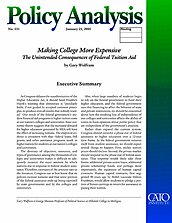The diversity of objectives, resources, and types of governance among the thousands of colleges and universities makes it difficult to adequately measure the exact amount by which tuitions rise in response to federal student assistance. Therefore, estimates of the amount vary in the literature. Congress can at best know that its policies increase tuitions and that some portion of the federal assistance ends up being captured by state governments and by the colleges and universities.
Also, when large numbers of students begin to rely on the federal government to fund their higher education, and the federal government uses this financing to affect the behavior of state and private institutions, we should be concerned about how the resulting loss of independence of our colleges and universities affects the ability of voters to form opinions about public policy that are independent of the government’s position.
Rather than expand the current system, Congress should consider a phase-out of federal assistance to higher education over a 12-year time frame. As the federal government removes itself from student assistance, we should expect several things to happen. First, sticker tuition prices should decline. Second, the private market should respond to the phase-out of federal assistance. That response would likely take three forms: additional private-sector loans, additional private scholarship funds, and perhaps most importantly, the expansion of human capital contracts. Human capital contracts, first suggested 40 years ago by Nobel Laureate Milton Friedman, would allow students to pledge a portion of future earnings in return for assistance in paying their tuition.

